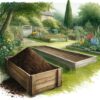Growing Peppers – Add a little spice to your life
Peppers, from sweet bell to fiery chili, add a dash of color and a burst of flavor to any garden. In today’s post, we’ll guide you step-by-step through the delightful journey of growing your very own peppers. Whether you’re a seasoned green thumb or a novice gardener, this comprehensive guide has something for everyone.
Why Grow Peppers?
There’s something uniquely satisfying about harvesting peppers that you’ve grown yourself. Besides being incredibly versatile in the kitchen, peppers are a boon to your health, packed with antioxidants and vitamins. Moreover, with their vibrant colors and varying shapes, they add aesthetic appeal to your garden.
Choosing the Right Variety
Selecting the right variety of peppers for your garden depends on your culinary needs and taste preferences. For those who prefer mild, sweet flavors, Bell peppers are an excellent choice, great for stuffing or adding crunch to your salads. Banana peppers, with their mild tang, are ideal for pickling or adding a zing to your sandwiches. Jalapenos are perfect for those who prefer a bit of heat without being overwhelming, making them a popular choice for salsas and stir-fries. If you’re a lover of extreme heat, go for Habaneros or Ghost peppers, which are among the hottest peppers in the world. If space is a constraint, consider miniature varieties like the compact and colorful ‘Basket of Fire’ which grows well in pots. Whichever type you choose, homegrown peppers are a rewarding and delicious addition to any garden.
Starting Peppers from Seeds
Starting peppers from seeds allows access to a wider variety of species, many of which may not be available as transplants. Start your seeds indoors, 8-10 weeks before the last expected frost. Use a well-draining seed-starting mix, plant the seeds about 1/4 inch deep, and maintain a temperature between 70-80 degrees Fahrenheit. Seedlings should appear in 2-3 weeks.
Master Gardener Tip: Pepper seeds need warm soil to germinate, so it is important to start them indoors if you live in a cold climate. You can plant them in seed trays or pots filled with a well-draining potting mix. Keep the soil moist and warm, and the seedlings should emerge in about 7-10 days.
Transplanting Your Pepper Seedlings
After the danger of frost has passed and your seedlings have grown to about 6 inches high, they’re ready for the great outdoors. Hardening off is crucial to prepare them for outdoor conditions. Gradually expose them to outdoor environments over a week, increasing their outdoor stay each day.
Site and Soil Requirements
Choose a location that gets at least 6 hours of full sun each day. Pepper plants prefer well-draining soil rich in organic matter, with a pH between 6.0 and 6.8. Space the plants 18-24 inches apart to allow for good air circulation.
Pepper Plant Care
Regular watering is crucial. Aim for a consistent, moderate watering schedule, as peppers don’t like to be too dry or too wet. Mulch around the base of the plants helps retain soil moisture and keeps the weeds at bay. Feed your plants with a balanced vegetable fertilizer every few weeks to promote robust growth and a bountiful harvest.
Harvesting Your Peppers
Most peppers can be harvested at any stage of maturity, but their flavor deepens as they change color. Cut the peppers off with scissors or a sharp knife to avoid damaging the plant.
Conclusion
Growing peppers is a rewarding gardening adventure, full of flavor, color, and satisfaction. So, why wait? Get your garden gloves on, follow our guide, and start planting!










